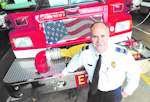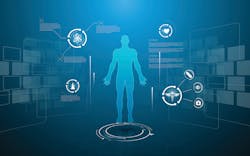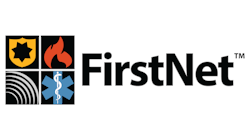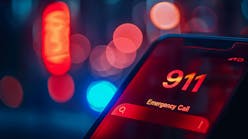Fire Technology: Looking Toward 2040
In the year 2040, a little more than 20 years away, fire service technology has changed dramatically. Moore’s law, the concept regarding computer exponential doubling, is now greatly enhanced by a variety of new technologies. As computer technology continues to increase capabilities and become more miniaturized—along with broadband connectivity, data storage, app development and smart devices—the convergence factor (CF) stimulates dramatic innovation at an unprecedented acceleration. With this in mind, the following is a personal prediction of a hopeful future that lies ahead.
Embedded technology and EMS response
By 2040, the Public Safety Internet of Things (PSIoTs) is the norm. Almost every aspect of operations has embedded chips, even under the skin of firefighters. These embedded chips are integrated into the FirstNet 10G LTE wireless network and serve to monitor the health status and location of personnel. Embedded technology detects vital signs, such as core body temperatures, respirations, high blood pressure and even illnesses (heart disease, stroke, cancer, etc.), and provides an instant defibrillation for the onset of a cardiac arrest. These chips are integrated into the enhanced location services, which has an accuracy of 10 cm to include X, Y and Z (floor level) metrics.
On the EMS side, embedded technology in people detects illness and injury and provides automatic wireless alerts to EMS as to patient condition, vital signs and location. This also immediately dispatches medics/ambulance, notifies hospitals of an incoming EMS patient through the new and improved Next Generation 9-1-1 (NG911) system.
In a rural area, with a long travel time to the hospital, medics interact directly with patients, monitor vital signs and provide medical instructions from afar, allowing for spontaneous access to patient medical records. Simultaneously, an EMS ambulance drone is dispatched to rural areas to quickly bring medics to the scene and transport the patient to the nearest hospital. All of this communication is in the form of data and is interconnected through the NG911 FirstNet Combined System and simultaneously alerts responders and hospitals.
Apparatus features
Apparatus are powered by hydrogen cells with longer operational periods and zero emissions, eliminating engine exhaust pollutants and contaminants. Apparatus have sensing technology to detect particulates that are harmful to firefighters. Rigs are equipped with chemical, biological, radioactive, nuclear, explosive (CBRNE) detection technology and initiate notification of on-board firefighters and central dispatch centers.
Apparatus technology monitors readiness of on-board systems, apparatus location, seatbelts in use, response route, speed and capture video from all four ground directions. Fire vehicles are equipped with GPS technology, which provides vehicle location and response routing, and captures/streams live video when responding to an incident. They also limit excess speed and erratic driving.
Apparatus serve as a network hub that provides additional FirstNet broadband signals where needed, especially in rural and remote areas. Most of the apparatus operate primarily as autonomous vehicles while allowing manual apparatus positioning upon arrival at the incident scene when necessary.
Apparatus send out signals to other vehicles and traffic systems, rerouting nearby drivers to an alternate and safer route to avoid an accident or incident scene. Apparatus are equipped with windshield heads-up display (HUD) with switching forward-looking infrared (FLIR) capability to see normal view or through smoke.
Most apparatus can carry, launch and operate an autonomous drone. Some command apparatus are one- or two-person drones, which may remain in flight during an entire incident or at least until the situation is reported under control.
Protective PPE
Protective clothing is designed to detect and eliminate cancer-causing agents upon contact. This gear has an internal mechanism with LED and wireless signal that indicates the presence of toxins and the need for the gear to be properly decontaminated. Protective clothing has a self-monitoring feature that identifies integrity or degradation of its protective capabilities. Fire helmets are designed to better integrate with SCBA facepieces for better protection.
SCBA are lightweight, miniaturized and fully replenishable without the need for external filling. SCBA is interconnected with FirstNet and relays necessary information to online monitoring systems that use artificial intelligence (AI) to identify health issues, periods of inactivity, SCBA status and notify the IC only when conditions warrant. SCBA facepieces include a HUD to show unit operation, air status, room temperature, identify fire particulates/gases and FLIR view. FLIR view is interconnected with AI and able to assess room conditions, and identify heat signatures, victims, holes in floors, fire spread and when flashover/backdraft situations are probable, also notifying the firefighter and the incident commander (IC) of hazardous conditions. All SCBAs are interconnected in such a way that the HUD directs other firefighters to a downed firefighter’s location. If a firefighter begins to exhibit health issues, the nearest firefighters and the IC are notified. The HUD also tracks the firefighters’ route and provides an escape route.
Enhanced communication
Land mobile radios (LMR) are transitioning to FirstNet, which, in 2040, has provided nationwide coverage, implemented a mission-critical push-to-talk (MCPTT) technology that works on the network and/or independently with device-to-device (DTD) communications, similar to talk-around of LMR today. The MCPTT works locally and anywhere in the United States. Public safety directories for local, state and federal agencies are accessible by smart devices. No longer is there a need for disparate LMR systems. Ruggedized smart devices are the primary means of communication and able to consume and share extensive public safety data.
NG911 captures data from individuals and buildings in the form of smoke/fire detector sensor data, video, thermal, digital imagery and share with responders and interact in real time. Enhanced location services quickly and accurately locate those in need as well the location and status of those responding to the call. Smart buildings are interfaced with NG911, allowing access to alarm systems, video, building schematics and floor plans. All of this is interactive with SCBA HUDs and integrated into smart city technologies.
Self-sufficient stations
Fire stations are designed to be fully self-sufficient with solar panel technology and hydrogen generators. Stations include environmental monitoring throughout to identify harmful gases and cancer-causing particulates and systems designed to eliminate contaminates.
Station systems include climate control, light control, station status, vehicle status, connection with autonomous vehicles, and door systems are automated and interconnected with apparatus. All stations are equipped with a new sanitizing technology that can quickly inspect and clean protective clothing to eliminate hazardous contaminants.
Drone usage
Drones are a mainstay within the fire service. Drones are flying routinely and able to detect fires, locate vehicle accidents, monitor wildfires and more as they occur. Autonomous drones are automatically dispatched by computer-aided dispatch (CAD) beyond visual line of sight (BVLOS) to structure fires, wildland fires, hazmat incidents, water rescues, lost persons incidents, technical rescues, floods, hurricanes, tornados, earthquakes, shark reports, civil unrest incidents and more. This prompt assessment/situational awareness identifies the magnitude of the incident and alerts when additional resources are needed or can be placed in service.
Drones serve as airborne IC operational vehicles (AICOV), allowing the IC or designee to observe incident operations from the air. They provide new firefighting technologies that can deploy safe extinguishment agents into high-rise fires, and they can make high-rise rescues. Drones serves as autonomous tankers to drop chemicals and water on wildfires while placing no pilot in harms way.
Drones serve as the primary EMS ambulance and can respond more quickly to rural areas and transport more quickly above congested urban streets. They are used to deliver medicine to underserved or difficult to access areas as well as to quickly transport human organs for transplant patients. Drones operate in swarms to search large areas more quickly and use AI and military target acquisition technology to identify anomalies in order to quickly locate lost persons.
Autonomous drones are integrated with ground robotics to provide first-person view (FPV). FPV provides overwatch by the drone and has sensors that detect the human heart beat and distinguish noises, such as a person yelling for help. Drones conduct two-way communications with a person in need and interact with a searcher or IC.
Sprinkler systems
Residential sprinkler systems have been transformed to disperse new safe disruptive fire chemistry agents (DFCA), which are inexpensive and are well received by all, as they do not create water damage when activated. All new buildings are designed with this technology and all existing water sprinkler systems are retrofitted. Similar portable pods are placed in kitchens of homes that are not equipped with sprinkler systems.
Robotics options
Robotics have progressed to the level where a human wearing a full-sensor suit with FPV can operate humanlike robots (HLRs) in hazmat, hostage, SWAT, bomb, explosive or similar situations. They can manipulate precision tools, open/close valves, repair container leaks and more. The robot is also equipped with CBRNE-detection sensors that automatically and quickly identify agents.
Robotics of varying sizes are designed for specific purposes, such as entry into confined spaces, mines, and collapsed buildings. Marine unmanned systems (MUS) are used to rescue drowning victims, monitor/sample hazmat situations on water, conduct autonomous patrol operations in ports, and even operate fire boats. All of this information is streamed in real time.
Training time
Training utilizes virtual reality (VR) and augmented reality (AR), and provides simulated training though various scenarios, creating a 3D atmosphere and the ability to move simulated objects and visualize conditions like flashover and backdraft, and interpret heat signatures through thermal imaging technology. Training rooms simulate heat and visibility conditions as well. This technology also exposes the responder to the types of uncommon life-threatening EMS scenarios that rarely occur in the field, so they have an opportunity to practice their response.
VR/AR is the first phase of driver training, with various driving scenarios to familiarize new driver/operators with specific apparatus driving characteristics, road conditions, traffic simulations, apparatus positioning, and apparatus operations. Mastering this phase is required before getting behind the wheel of any emergency vehicle.
VR/AR is used to train basic and advanced life support (BLS/ALS) procedures and allows safe and non-punitive ways to learn and practice. Once the proficiency is achieved, the EMS provider can be tested and certified virtually when convenient to the responder.
All of these activities are conducted without any danger to the firefighter.
Embrace the change
Technology continues to enhance operations, safety and firefighter survivability. Firefighters and the community benefit from the automation and speed of data access and dissemination. However, some people view some of these technologies as disruptive and resist their implementation. The ability to change culture is the key to successful implementation and determines how quickly this new technology is adopted. It is time to think about the future and plan ways to implement technological advancements in a way that reduces firefighter injuries and line-of-duty deaths.

Charles Werner
CHARLES WERNER, who is a Firehouse contributing editor, is a 45-year veteran of public safety. He served with the Charlottesville, VA, Fire Department for 37 years, serving the past 10 years as chief. Following retirement, Werner served for two years as senior adviser and acting deputy state coordinator for the Virginia Department of Emergency Management. He has chaired: DHS SAFECOM Executive Committee; IAFC Technology Council; National Information Sharing Consortium; and DHS/White House Incident Management Information Sharing SubCommittee. Werner currently serves as the director of DroneResponders Public Safety Alliance, chair of the National Council on Public Safety UAS and chair of the Virginia Secure Commonwealth UAS Sub Panel.








